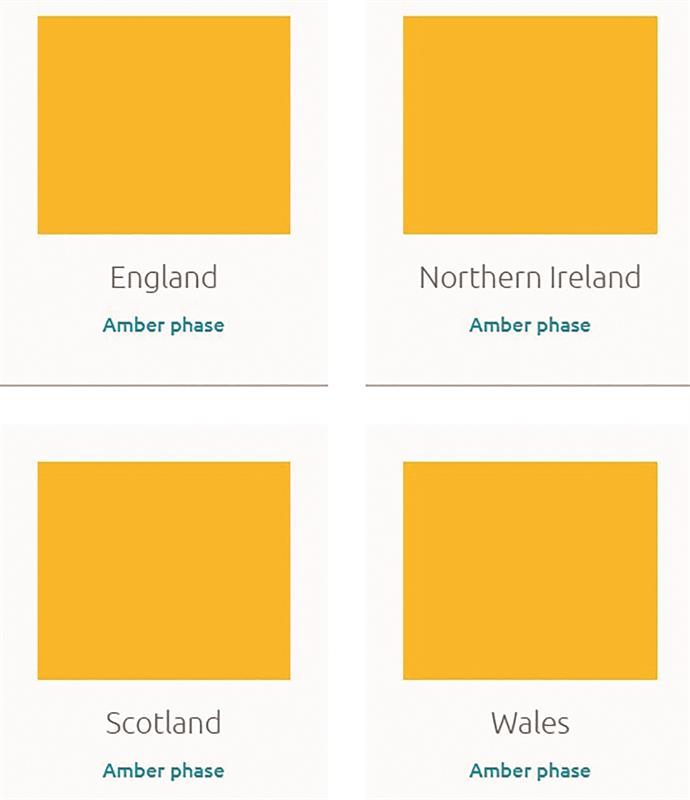
We are now at a stage where all four countries of the UK are in the amber phase of the pandemic response (figure 1). This means that eye care practice may resume, including offering ‘routine’ service, but obviously with some provisos. To quote the College of Optometrists (CoO), ‘We advise that optometrists continue to triage patients, over the phone or virtually, to assess their needs before an appointment is made. This would mean that low-risk asymptomatic patients are not prioritised until we have reached a point of low community transmission.’
 Figure 1: College of Optometrists website signalling amber phase on 29.06.20
Figure 1: College of Optometrists website signalling amber phase on 29.06.20
The key here has to be prioritisation. An asymptomatic elderly patient may have some previously identified risk factors for, for example, glaucoma. That said, there are inherent risks in travel and in face-to-face assessment. So, each case needs to be considered individually, both in assessment of risk and in the timescale predicted of any potential complications. I suggest, optometrists are well equipped to make such decisions and respond sensibly to patient-driven requests for consultation.
Royal Society of Medicine
There have been many, excellent webinars and online discussions taking place recently. One strand worth pointing out has been the series broadcast by the Royal Society of Medicine under the RSMLive title (www.rsm.ac.uk/resources/rsm-live) (figure 2). Last week, this included a discussion chaired by a familiar old face (and Immediate Past President RSM General Practice with Primary Healthcare) Bob Hutchinson. After emphasising the
current situation and the need for prioritisation, the chair introduced a GP with a special interest in ophthalmology (Dr Waqar Shah) and a consultant ophthalmologist (Professor Paul Ursell), and asked for their thoughts on the post-Covid period (figure 3).
 Figure 3: Professor Paul Ursell (left) and Dr Waqar Shah (right)
Figure 3: Professor Paul Ursell (left) and Dr Waqar Shah (right)
Dr Shah has long been a supporter of community optometry (I had previously interviewed him for one of the DOCET programmes) and so he was well aware of the importance of our role during a period where there is a significant backlog in hospital ophthalmology appointments. He explained how much of his current work has involved liaising with allied professionals in providing care, ranging from talking therapies for mental welfare, arranging debt counselling with finance agencies, and finding support for the bereaved. Specific to eye care, he emphasised the need for a quick return of full retinopathy screening for diabetics. He then used the example of a telephone consultation which suggested a central retinal vein occlusion to show how a referral to a community optometrist for confirmation had better used resources by avoiding an unnecessary GP appointment and also ensured any HES referral was valid. More GPs need to think this way.
Professor Ursell was seeing a big upsurge in demand for his services. During lockdown, much had been done over the phone (‘good for lids and emergency triage, not so good where diagnostic testing needed’). He suggested that full electronic records had meant his hospital was able to cope well, and that moving ahead, excellent schemes such as CUES, might be better supported with improved electronic communications between primary and secondary care. One step might be better involvement from optometrists in the database of eye research-active staff at hospital-level called OPERA (OPhthalmology Encyclopedia of Research Architecture). These sorts of recommendations are important and those of us with access to, for example, OCT would greatly benefit from a better system for transfer of digital records for analysis.
With future debates including subjects such as care of the elderly post-Covid, I strongly recommend a visit to the RSM
website.
Masks
The use of masks in the public space has become somewhat muddied by conflicting advice from various quarters in previous months. As face-to-face consultation requires a journey through the public space, and as triaging based on symptoms only detects those with Covid-19 symptoms (some studies mention up to 58% of infected patients may be asymptomatic – see Optician; 19.06.20) infection en route to practice must be minimised.
A new paper from the US1 has figures that show the importance of using face masks in public. As restrictions have eased, some 15 states plus the District of Columbia have mandated for the use of face masks in public, while the others have been less strict. The results clearly show that ‘mandating public use of face masks is associated with a reduction in the Covid-19 daily growth rate.’ Important findings, I suggest.
And finally
Some interesting bedtime reading – an Australian journal, Clinical and Experimental Optometry, started publishing during the Spanish flu pandemic. Last week they ran a fascinating editorial (by the Efrons) highlighting optometry then and now and what we need to learn from these events.2 •
References
- Lyu W et al. Community Use of Face Masks and Covid-19: Evidence From A Natural Experiment Of State Mandates In The US. doi:10.1377/hlthaff.2020.00818
- Efron N et al. Optometry in times of pandemic: Spanish flu (1919) versus Covid-19 (2020). DOI:10.1111/cxo.13094
